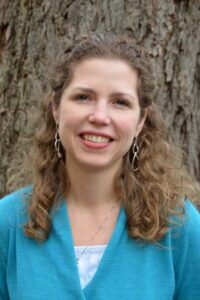Angela Eeds, Ph.D.
Director
Educational Background
Vanderbilt University: 2006
Department of Molecular Physiology and Biophysics & the Center for Human Genetic Research
On Teaching
Through the example of both educators in my family and professors integral to my academic career, I have a passion for learning and learning by teaching others. I believe that to be an effective teacher requires also being an enthusiastic mentor. I enjoy the discovery and hands-on approach of science and I firmly believe that the best way to learn is by participation – to not only visualize but also contribute to scientific discovery. However, beyond learning about science and scientific inquiry, it is my goal to ensure that all students develop the skills of a broader education by integrating math, writing, communication, and critical thinking skills. The most important job of an educator is to provide students with the communication and critical thinking tools necessary to succeed in any endeavor they pursue.
Research
The focus of my studies has been on genetics and molecular biology. Beyond mutation detection, I am interested in finding ways that genetic changes can be used as a tool to understand more about molecular biology in general. For my dissertation, I identified mutations in patients with CPSI Deficiency, a rare genetic disorder affecting the urea cycle. I then designed a way to rapidly introduce these mutations into cells. From these cells, I was able to isolate DNA and RNA to differentiate between mutations that affect RNA stability and those that affect the final protein product. This project was valuable because understanding how a mutation affects the pathway from DNA to protein is not only helpful in determining the molecular cause of a certain disease phenotype, but should also be used to understand how gene expression occurs in general. I have also worked with other interesting genetics research projects including a marine biology project (while I was an undergraduate) where I studied the genetics of a fish population on the Mississippi Gulf Coast. And, during my post-doctoral research, I used genetic reporter systems to study the gene expression patterns important for proper nervous system development in the gut.
Publications
- Eeds, AM, Vanags, CP, Creamer, JI, Loveless, ME, Dixon, AL, Sperling, H., McCombs, G, Robinson, D, Shepherd, VL. “The School for Science and Math at Vanderbilt: An Innovative Research-Based Program for High School Students.” Cell Biology Education Life Sciences Education, 2014,(13):297-310.
- Häberle, J., Shchelochkov, OA, Wang, J, Katsonis, P, Hall, L, Reiss, S, Eeds, A, Willis, A, Yadav, M, Summar, S, and the Urea Cycle Disorders Consortium, Lichtarge, O, Rubio, V, Wong, L-J and Summar, M (2011), “Molecular defects in human carbamoy phosphate synthetase I: mutational spectrum, diagnostic and protein structure considerations.” Human Mutation. 2011Jun; 32 (6):579–589.
- Eeds AM, Mortlock DP, Wade-Martins R, Summar ML. “Assessing the functional characteristics of synonymous and nonsynonymous mutation candidates by use of large DNA constructs.” American Journal of Human Genetics, 2007 (80):743-750.
- Eeds AM, Hall LD, Yadav M, Willis A, Summar S, Putnam A, Barr F, Summar ML. “The frequent observation of evidence for nonsense-mediated decay in RNA from patients with carbamyl phosphate synthetase I deficiency.” Molecular Genetics and Metabolism. 2006 Sep-Oct; 89(1-2):80-6.
- Summar ML, Hall L, Christman B, Barr F, Smith H, Kallianpur A, Brown N, Yadav M, Willis A, Eeds A, Cermak E, Summar S, Wilson A, Arvin M, Putnam A, Cunningham G. 2004. “Environmentally determined genetic expression: clinical correlates with molecular variants of carbamyl phosphate synthetase I.” Molecular Genetics and Metabolism. 2004 Apr; 81 Suppl 1:S12-9.
- Summar ML, Hall LD, Eeds AM, Hutcheson HB, Kuo AN, Rubio V, Arvin MK, Schofield JP, Dawson EP. “Characterization of genomic structure and polymorphisms in the human carbamyl phosphate synthetase I gene.” Gene. 2003; 311:51-57.
- Boustead JN, Stadelmaier BT, Eeds AM, Wiebe PO, Svitek CA, Oeser JK, O’Brien RM. “Hepatocyte nuclear factor-4alpha mediates the stimulatory effect of peroxisome proliferator-activated receptor gamma co-activator-1alpha (PGC-1alpha) on glucose-6-phosphatase catalytic subunit gene transcription in H4IIE cells.” Biochemical Journal. 2003 Jan 1; 369(Pt 1):17-22.
- Spiekerkoetter U, Eeds A, Yue Z, Haines J, Strauss AW, Summar M. “Uniparental disomy of chromosome 2 resulting in lethal trifunctional protein deficiency due to homozygous alpha-subunit mutations.” Human Mutation. 2002 Dec; 20(6):447-51.
Awards
Mentorship Excellence Award, 2023. Vanderbilt University
Distinguished Science Teacher, 2013. Tennessee Academy of Science
CONNECT WITH SSMV

